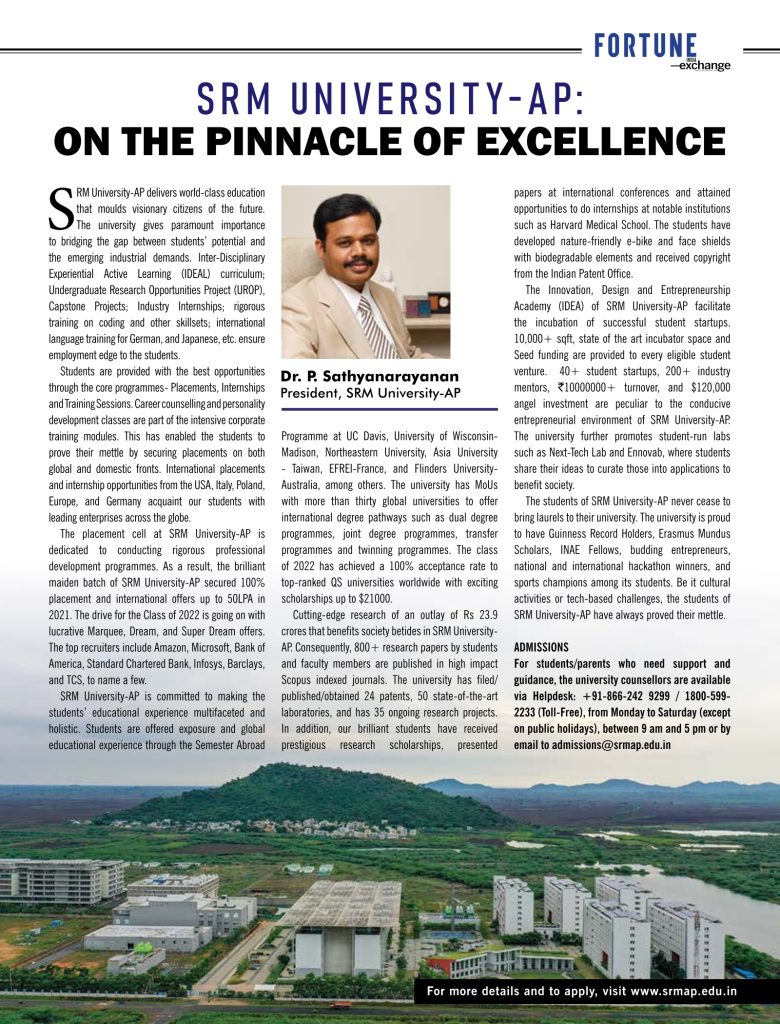All Management News
- Dr Nityananda Roy June 18, 2022
- Mechanical engineering students develop multi-utility buggy car June 17, 2022
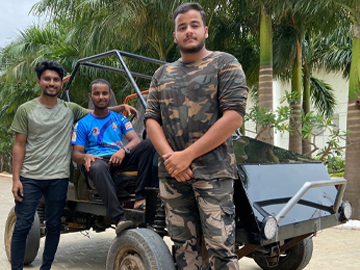 Stories of innovation from SRM AP are not something new! M Tanveer, G Sai Venkat, and Divyansh Awasthi, three vibrant students from the Department of Mechanical Engineering at SRM University-AP, have built a multi-utility buggy car as a part of their final year project work.
Stories of innovation from SRM AP are not something new! M Tanveer, G Sai Venkat, and Divyansh Awasthi, three vibrant students from the Department of Mechanical Engineering at SRM University-AP, have built a multi-utility buggy car as a part of their final year project work.The students initially planned to build a completely new multi-utility vehicle. Later they slightly modified the idea to make a buggy car from scrap materials, i.e. by gathering the efficiently working components from old and unused cars and making them compatible with the chassis.
Motivated by their admiration for the automotive industry, students had great enthusiasm for building the buggy car. They had an urge to convert theoretical knowledge gained from classrooms into practical working machines. Consequently, the trio developed an off-road diesel buggy to show their prowess in the automobile industry, especially on and off-road cars. A Diesel motor is utilised, which is competent in conveying a speed of 50 kilometres per hour.
The chassis of the buggy is designed and manufactured by the students themselves. The spare parts and connection are from the TATA ZIP car model and incorporated into the buggy fitting to the design. The necessary fitting and binding of spare parts are done according to the driving comfort.
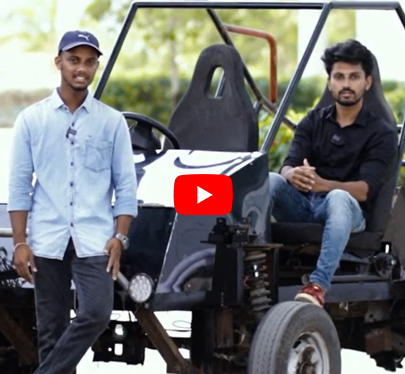
The students expressed their gratitude for the support of their project guide Dr Jasvinder Singh, co-guide Prof Venkata N Nori, and HOD Prof Prakash Jadhav. “We received constant mentorship and guidance throughout our project tenure from them”, said the students. “Whenever we were stuck or were not able to solve a particular problem, or at times were mentally stressed and worn out, our professors gave us proper guidance to warded off our problems and stress, ” they added.
Continue reading → - Dr K A Sunitha June 16, 2022
- On an invasive shrub that alters the flora and soils June 16, 2022
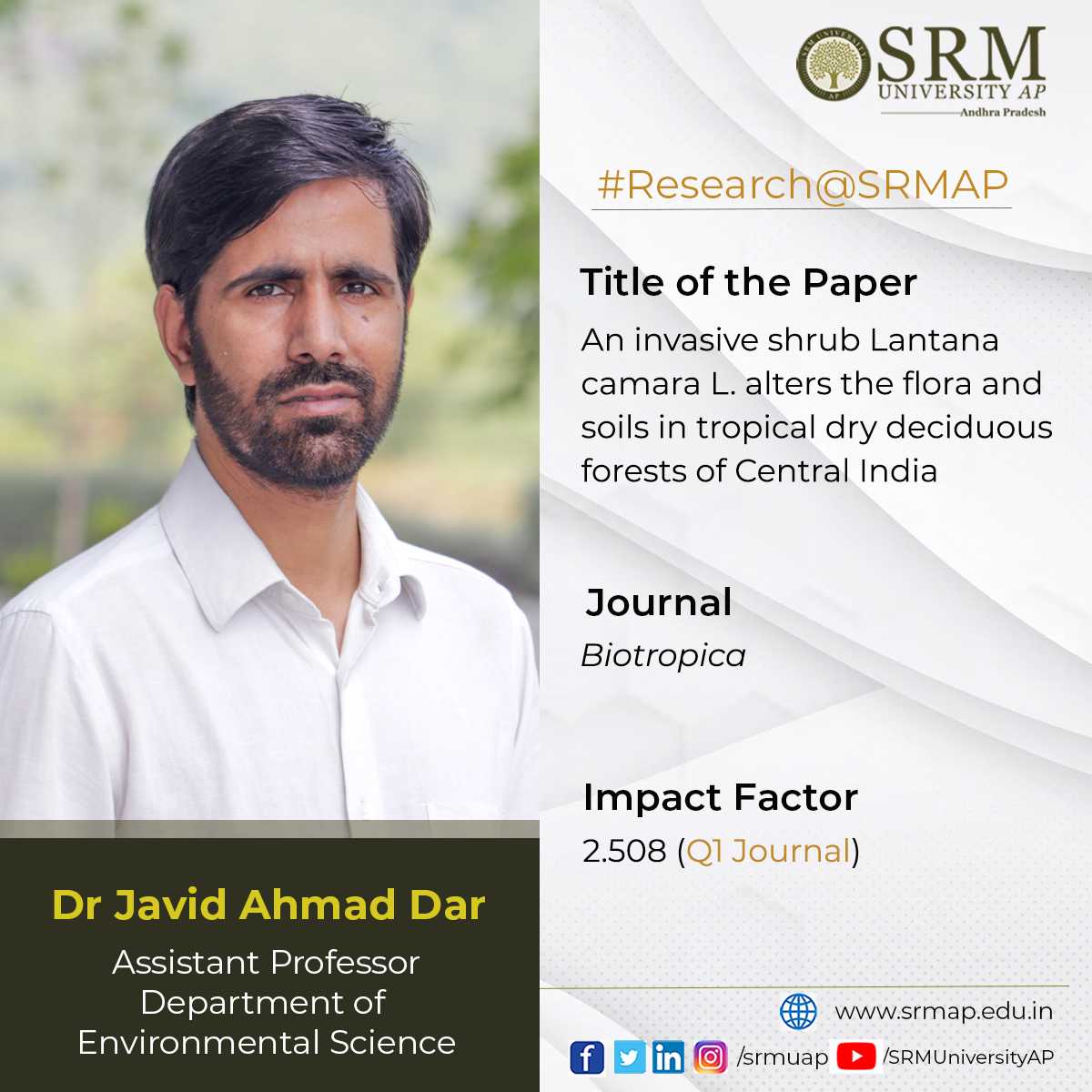 The paper titled “An invasive shrub Lantana camara L. alters the flora and soils in tropical dry deciduous forests of Central India” has been published by Dr Javid Ahmad Dar, Assistant Professor of Environmental Science at SRM University-AP, in “Biotropica” having an impact factor 2.508 (Q1 Journal).
The paper titled “An invasive shrub Lantana camara L. alters the flora and soils in tropical dry deciduous forests of Central India” has been published by Dr Javid Ahmad Dar, Assistant Professor of Environmental Science at SRM University-AP, in “Biotropica” having an impact factor 2.508 (Q1 Journal).Abstract
The findings of this research reveal how an invasive shrub Lantana camara L. significantly alters the flora and soils in tropical dry deciduous forests of Central India and suggested long-term monitoring studies and proper management strategy.
Practical implementation
The findings would be helpful to forest managers, scientists and policymakers for better understanding, management, and restoration of the invaded landscapes in tropical forest ecosystems.
Collaborations
Prof M. L. Khan, Department of Botany, Dr Harisingh Gour Vishwavidyalaya (A Central University), Sagar, Madhya Pradesh, India.
Prof Raman Sukumar, Centre for Ecological Sciences, Indian Institute of Science (IISc), Bengaluru, India.
Prof Mukund Dev Behara, CORAL, Indian Institute of Technology, Kharagpur, West Bengal, India.
Prof S. M. Sundarapandian, Ecology and Environmental Sciences, Pondicherry University, Puducherry, India.Future research plans:
Dr Javid Dar’s research plan for the next five years is to bring together several unique aspects of forest ecology which will be focused on carbon dynamics, mortality, microbial diversity and their relationship in shaping the structure and functional aspects of different forest ecosystems in the on-going and future climate change. Another major aspect of the research will be, to focus on ecophysiology and plant functional trait analysis in forest ecosystems as they are vulnerable to climate change and to see the impacts of climate change on diversity, productivity and stand structure in tropical and temperate forest ecosystems.
Continue reading → - The key to a successful job interview June 16, 2022
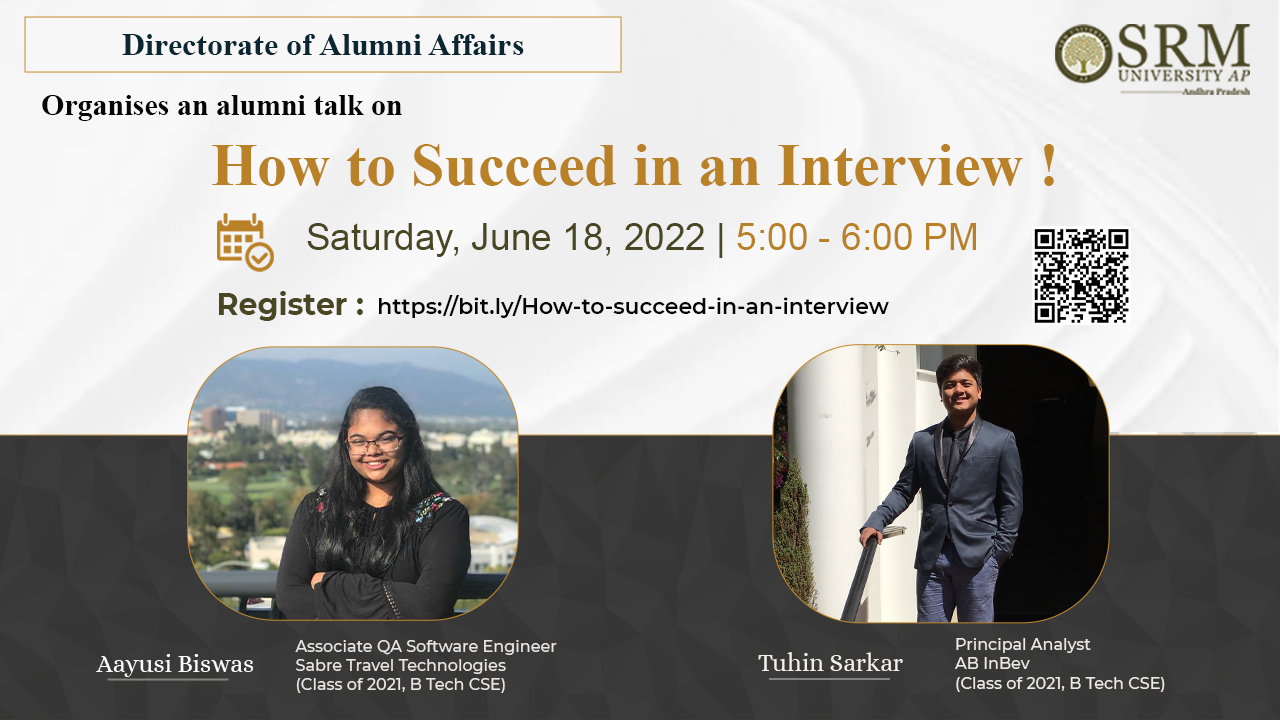
Facing an interview is a nightmare for many. There may be multiple factors lowering your level of confidence. Your depth of knowledge, ability to communicate, body language, dressing style, and an endless list of reasons could affect you in being yourself during an interview. While most of us are highly qualified academically, many are still groping in the dark to present ourselves as professionally qualified. And the sad fact is that, it is your professional persona that wins you a better chance of clearing the interview than your academic qualifications.
The Directorate of Alumni Affairs has scheduled a webinar on ‘How to succeed in an Interview’ with our notable alumni, Aayusi Biswas and Tuhin Sarkar from the Class of 2021, Computer Science and Engineering. Aayusi currently holds the position of Associate QA Software Engineer at Sabre Travel Technologies while Tuhin works as a Principal Analyst at AB InBev.
Date: June 18, 2022
Time: 5.00 pm to 6.00 pm IST
The session aims to groom students to give out their best in any interview. Effective training and practice sessions can bridge the gap in one’s academic expertise and career advancement. The more confident you are in being yourself, the better your possibility of winning your dream job.
Register for the session and walk in confidently for all the interviews ahead!
- Fortune India Magazine Publication June 15, 2022
- A unique bridging facets assembly of gold nanorods June 15, 2022
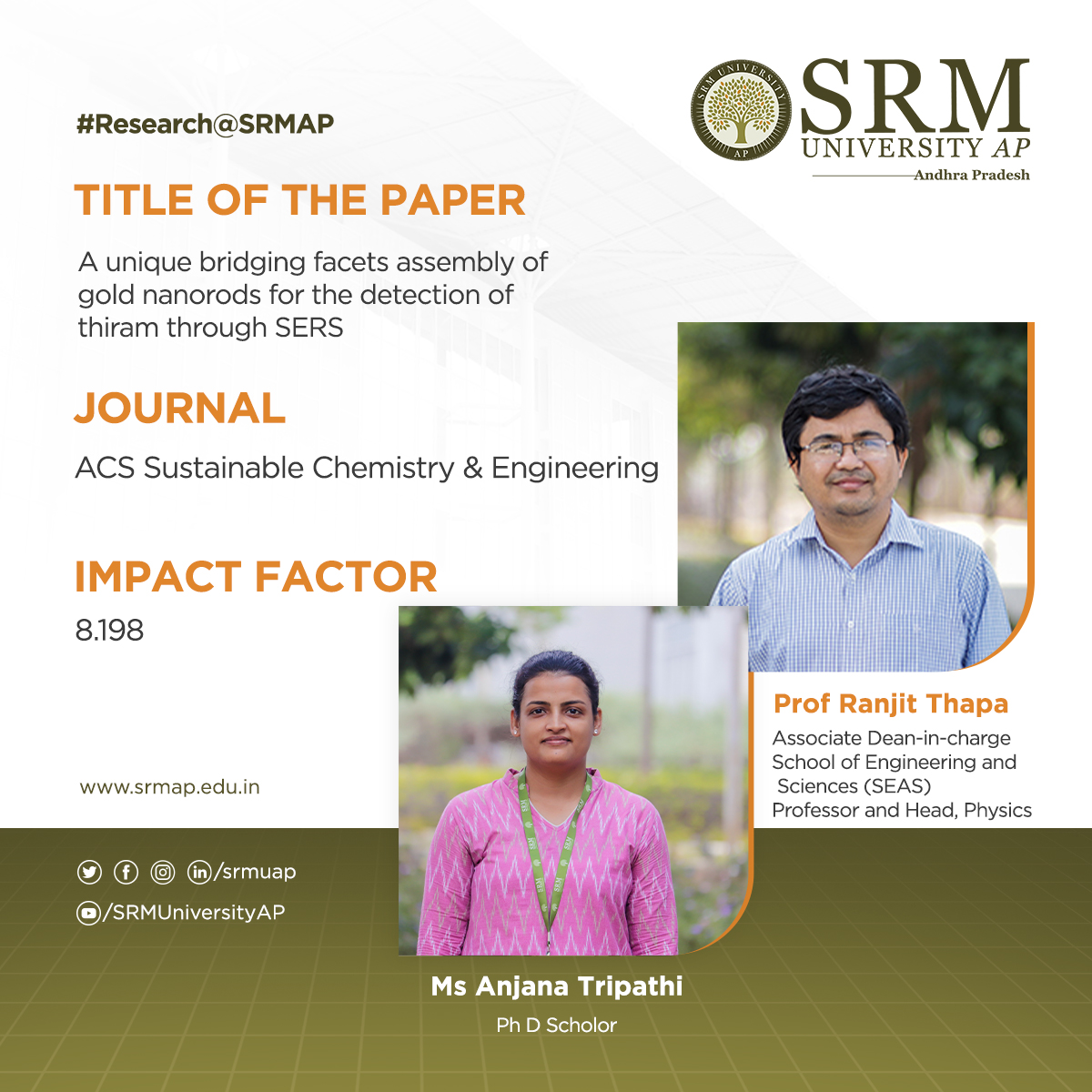 The paper “A unique bridging facets assembly of gold nanorods for the detection of thiram through SERS” has been published by Prof Ranjit Thapa, Professor of Physics and his PhD student, Ms Anjana Tripathi, in ACS Sustainable Chemistry & Engineering having an Impact Factor of 8.198.
The paper “A unique bridging facets assembly of gold nanorods for the detection of thiram through SERS” has been published by Prof Ranjit Thapa, Professor of Physics and his PhD student, Ms Anjana Tripathi, in ACS Sustainable Chemistry & Engineering having an Impact Factor of 8.198.Abstract
The addition of Au NRs (Gold Nanorods) to TRM (Thiram) of higher and lower concentrations, yields side-by-side assembly (SSA) and bridging facets assembly (BFA), respectively, and exhibited excellent hotspots for the ultra-low detection of TRM. Bridging facets of Au NRs, such as (5 12 0) and (5 0 12) planes are mainly responsible for the BFA. This kind of interaction is observed for the first time and not reported elsewhere. The detailed facets of Au NRs, namely side facets, bridging facets, and pyramid facets, were discussed with the 3D model of Au NRs. The computational studies confirm the SSA and BFA for Au NRs with varying concentrations of TRM are well in agreement with the experimental results.
Research in brief
Au NRs were synthesized successfully using the seed-mediated method and characterized by UV-Vis analysis, SEM, TEM, FT-IR, Raman, and XPS analysis. Synthesized Au NRs were employed for the detection of TRM. Upon adding Au NRs to TRM of higher and lower concentrations yields side by side (SSA) and bridging facet assembly (BFA), validated by TEM analysis. This unique BFA was observed for the first time and not reported before to the best of our knowledge. Elemental mapping confirms the good adsorption of TRM over Au NRs, and FT-IR, Raman, SERS, and XPS analysis confirm the adsorption of TRM on Au NRs through Au-S bond. A uniformity study was performed for the TRM-Au NRs sample using 25 random places and obtained an RSD of ≤ 10% for each peak in SERS. This shows TRM is uniformly adsorbed on Au NRs. LOD and EF were achieved at 10 pM and 2.8 ×106, respectively. Hence, Au NRs are considered an excellent substrate for the detection of TRM. The unique assembly of BFA may play a significant role in the research community to further study the facet-dependent interactions of nanostructures. The computational study was performed to know the reason behind SSA and BFA. The density functional theory (DFT) was carried out using the Vienna Ab-initio Simulation Package (VASP). The Perdew-Burke-Ernzerhof (PBE) functional within Generalized Gradient Approximation (GGA) is adopted to treat the exchange-correlation interactions. These studies confirm the formation of a strong bond between Au and S, as well as the SSA and BFA for higher and lower TRM concentrations with Au NRs. The binding energy of TRM in SSA and BFA is -3.81 eV and 3.19 eV respectively. From the theory, it shows that TRM of lower concentration form BFA and higher concentration of TRM, due to high barrier energy for TRM diffusion, Au NRs form SSA. In this respect, we calculated the activation barrier for thiram migration from edge site (BFA) to in between site (SSA). Results indicate that TRM needs 2.40 eV energy to migrate from the edge site to in between site to form side-by-side assembly. Therefore, for diffusion from edge to in between (SSA) site high-energy barrier is required i.e. higher concentration is required for such configuration. Hence, at low concentration, TRM will form bridge facet assembly and due to high barrier energy for TRM diffusion, the side-by-side assembly is possible only at high concentration.
Practical implementation/social implications
Concerns have grown in recent years about the widespread use of the pesticide thiram (TRM), which has been linked to negative effects on local ecosystems. This highlights the critical need for quick and accurate point-of-need pesticide analysis tools for real-time applications. The detection of TRM using gold nanorods (Au NRs) with a limit of detection (LOD) of 10-11 M (10 pM) and an enhancement factor (EF) of 2.8 × 106 along with 6.2% of signal homogeneity (with respect to peak at 1378 cm-1) achieved through surface-enhanced Raman scattering (SERS). The interaction of Au NRs with TRM is sensitive, and ultra-low detection of hazardous TRM through SERS makes an ideal technique for environmental protection, real-time applications, and analysis of one-of-a-kind materials.
Collaborations
Bhavya M. B, Akshaya K. Samal
Continue reading →
Institute: Centre for Nano and Material Sciences, Jain University, Jain Global Campus
Ramanagara, Bangalore 562112, India - Mr Aaditya Jain’s article featured in Brainz magazine June 15, 2022
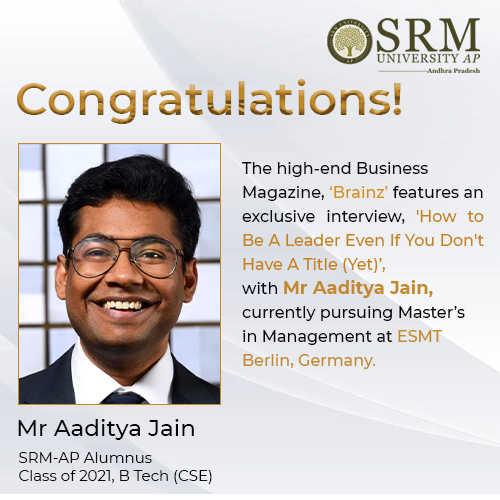
The leaders of tomorrow are defined by the clarity of thought in translating their vision into action. Their words reflect the undying spirit to make it big in life and brace up the world for unforeseen challenges in the times to come. Currently pursuing Master’s in Management at ESMT Berlin, Mr Aaditya Jain, the alumnus of Class of 2021, Computer Science and Engineering, is one such promising leader who is on an endeavour to gear up his personal and professional limits with a solid vision and impeccable work ethic. The high-end Business magazine of Europe, ‘Brainz’ has recently featured his article titled ‘How to Be A Leader Even If You Don’t Have A Title (Yet)’.
Brainz magazine is a global digital periodical that brings influential entrepreneurs, coaches, and business experts to share their knowledge and stories with the world. It features articles across various themes- exploring business innovations, leadership mindsets, aspirational lifestyles, and many more. The magazine aims to disperse inspiring content to augment the quality of life in all aspects. In an interview with Snježana “Ana” Billian, Aaditya shared the top four tips on how to show leadership at work, even if you don’t have a leadership title. As far as he is concerned, one must lead oneself before venturing out to lead others.
Aaditya pronounces the importance of self-awareness as it gives the opportunity to capitalize on one’s strengths and weaknesses to create as much value as possible in every situation. “One of the most powerful things I was told by one of my professors back during my undergrad is: We have all the resources within us. This statement inspired me to embark on a journey of self-discovery” he remarked. Aaditya is also aware of the huge benefit of the internet. Sharing one’s views and experiences online does not require a title. He regularly shares his experience at work and the lessons he learned on leadership online. This makes it easier for him to reach out to like-minded people and create a shared value.
“The need to mould oneself as a proactive communicator and concoct a support network at professional space is essential to ensure one’s career advancement”, says Aaditya. He believes, that asking out for help is a quality that must be encouraged. He further went on to divulge how moving to Germany and settling in was not an easy job. But according to him, the greatest challenge was how to make the most out of it. Success in the words of Aaditya is, “Living my values while continuously growing and inspiring human leadership at work”.
Here is the link to his article: https://www.brainzmagazine.com/post/how-to-be-a-leader-even-if-you-don-t-have-a-title-yet
Continue reading → - Hon’ble Minister Smt Vidadala Rajini inaugurates SRM AP blood donation camp June 14, 2022
Organised in association with the Indian Red Cross Society and STEP Swasakthi Guntur
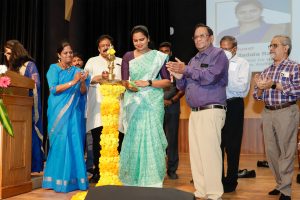 Around 140 students, faculty, non-teaching staff, and administrative members of SRM University-AP participated in the blood donation camp organised as a part of World Blood Donor Day. “You are really fortunate to be a part of this world-class university”, said Chief Guest Ms Rajini Vidadala, Hon’ble Minister for Health & Family Welfare-Government of Andhra Pradesh. She also acknowledged the CSR initiatives and commitment toward social causes by SRM Medical College and Research and the SRM group of institutions.
Around 140 students, faculty, non-teaching staff, and administrative members of SRM University-AP participated in the blood donation camp organised as a part of World Blood Donor Day. “You are really fortunate to be a part of this world-class university”, said Chief Guest Ms Rajini Vidadala, Hon’ble Minister for Health & Family Welfare-Government of Andhra Pradesh. She also acknowledged the CSR initiatives and commitment toward social causes by SRM Medical College and Research and the SRM group of institutions.In his presidential address, Pro-Vice-Chancellor Prof D Narayana Rao talked about the virtue of regular, voluntary, and unpaid blood donations. He further highlighted SRM University-AP’s achievements in building next-generation world-class scientists and innovators. He narrated the university’s commitment to creating a conducive research ecosystem.
World Blood Donor Day is observed on June 14 every year around the world to promote awareness about the need for safe transfusion and honour blood donors for their selfless act of saving lives. This year WHO observes the day on the theme “Donating blood is an act of solidarity. Join the effort and save lives”.
“This is the fourth time I am donating blood from SRM AP. I feel so proud and happy to be a part of this noble deed,”- says Ms Shalini Jayakumar, Assistant manager- Office of Examinations. She also encouraged women to come forward and donate blood without the fear of after-effects.
Certificates were distributed to the benevolent blood donors of SRM University-AP. Prof D Narayana Rao felicitated the Hon’ble Minister with a memento for her prolific contributions to society. The blood donation camp was organised in association with the Indian Red Cross Society (IRCS) and STEP Swasakthi Guntur. Addressing the gathering, Ramachandra Raju- Vice Chairman, IRCS Guntur, appreciated the non-teaching staff for being the leading light to students. NSS Coordinator of the university, Dr Lakshman Rao and Programme Officer Dr Pardha Saradhi Maram highlighted the role of blood donation in saving lives.
Dr R Premkumar-Registrar, Ms Suma N- Chief Finance and Accounts Officer (CFAO), Ms Revathi Balakrishnan- Student Affairs Assistant Director, Deans and Associate Deans of various schools, and Directors and Associate Directors of different departments were present at the meeting held at the university auditorium.
Continue reading → - Enhanced charge transport behaviour of protein-metal nanocluster hybrid June 14, 2022

Proteins are the most vital life forms which maintain close coordination with almost living activities through their biological functions. Nevertheless, in most cases, proteins suffer from low charge (electron) transfer efficiency as they are mainly made of insulating organic molecules. The interdisciplinary research publication, of Dr Sabyasachi Mukhopadhyay and Dr Sabyasachi Chakrabortty from the Department of Physics & Department of Chemistry respectively, along with their PhD scholars: Ms Ashwini Nawade, Mr Kumar Babu Busi and Ms Kunchanapalli Ramya, envisions the molecular-level understanding of the charge transport behaviour of various protein-metal nanocluster hybrid.
The article titled ‘“Improved Charge Transport across Bovine Serum Albumin – Au Nanoclusters’ Hybrid Molecular Junction” was featured in the prestigious Q1 journal ACS Omega (IF: 3.512), published by the ‘American Chemical Society’. They successfully incorporated Gold Nanoclusters inside the protein backbone leading to an increase in their conductivity. This will provide new avenues for the rational design of bioelectronic devices with optimized features. The BSA-Au cluster has been a promising model for bioelectronic functionalities. With an increase in their current carrying capacity, they can be used for many more applications, especially as the interface between tissue and organ in biocompatible devices. The research team is also planning to work with various protein dopants to understand their charge transport mechanism. These studies will help in using the protein for various applications mainly in bioimplants or biosensors for drug testing and diagnostics purposes.
Abstract of the Research
Proteins, a highly complex substance, have been the essential element in the living organism where various applications are envisioned due to their biocompatible nature. Apart from protein’s biological functions, contemporary research mainly focuses on their evolving potential associated with nanoscale electronics. Here, we report one type of chemical doping process in model protein molecules (BSA) to modulate its electrical conductivity by incorporating metal (Gold) nanoclusters on the surface or within it. The as-synthesized Au NCs incorporated inside the BSA (Au 1 to Au 6) were optically well characterized with UV-Vis, time-resolved photoluminescence (TRPL), X-ray photon spectroscopy, and high-resolution transmission electron microscopy techniques. The PL quantum yield for Au 1 is 6.8% whereas Au 6 is 0.03%. In addition, the electrical measurements showed ~10-fold enhancement of conductivity in Au 6 where maximum loading of Au NCs was predicted inside the protein matrix. We observed a dynamic behaviour in the electrical conduction of such protein-nanocluster films, which could have real-time applications in preparing biocompatible electronic devices.
Continue reading →


